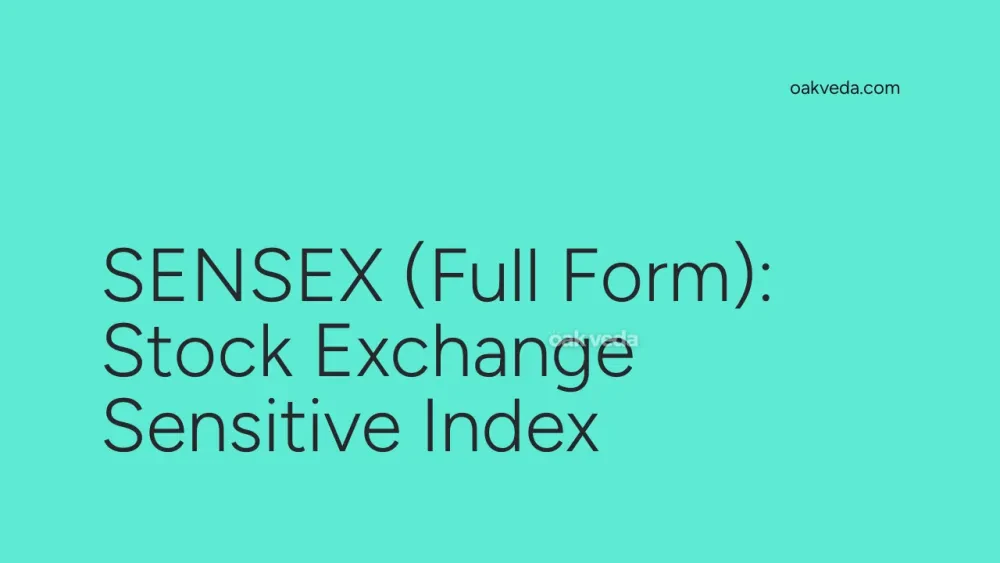
What is the Full Form of SENSEX?
SENSEX is an abbreviation for the Stock Exchange Sensitive Index. This widely recognized term is crucial in the Indian financial landscape, serving as a benchmark index for the Bombay Stock Exchange (BSE), one of the oldest and most prominent stock exchanges in Asia.
What is Stock Exchange Sensitive Index?
The Stock Exchange Sensitive Index, commonly known as SENSEX, is a free-float market-weighted index that represents the performance of 30 well-established and financially sound companies listed on the Bombay Stock Exchange. These companies, often referred to as blue-chip companies, are leaders in their respective industries and serve as a barometer for the Indian economy's health and performance.
Origin and Development of SENSEX
SENSEX was first introduced on January 1, 1986, with a base value of 100 points. Over the years, it has evolved to become the most widely tracked Indian equity index. The index's composition is reviewed semi-annually to ensure it accurately reflects the current market conditions and economic landscape.
How does SENSEX work?
SENSEX operates as a weighted average of its 30 constituent stocks. The weightage of each company in the index is determined by its free-float market capitalization. This means that companies with higher market values and more freely tradable shares have a greater impact on the index's movement.
The index is calculated in real-time during market hours, providing investors with a snapshot of the overall market sentiment. A rise in the SENSEX indicates a bullish trend in the market, while a fall suggests bearish sentiment.
Functions of SENSEX
-
Market Indicator: SENSEX serves as a key indicator of the Indian stock market's performance and, by extension, the country's economic health.
-
Benchmark: It provides a benchmark against which fund managers and individual investors can measure their portfolio performance.
-
Economic Barometer: SENSEX is often used as a barometer for the Indian economy, reflecting investor confidence and economic growth prospects.
-
Investment Tool: The index forms the basis for various financial products, including index funds and exchange-traded funds (ETFs).
Applications of SENSEX
-
Portfolio Management: Investors and fund managers use SENSEX as a reference point for creating and evaluating their investment portfolios.
-
Economic Analysis: Economists and policymakers analyze SENSEX trends to gauge the overall economic sentiment and make informed decisions.
-
Derivative Trading: SENSEX serves as the underlying asset for various derivative products, including futures and options.
-
International Comparisons: Global investors use SENSEX to compare the Indian market's performance with other international markets.
Features of SENSEX
-
Diverse Representation: The index includes companies from various sectors, providing a comprehensive view of the Indian economy.
-
Free-float Methodology: SENSEX uses a free-float market capitalization method, which considers only the tradable shares of a company.
-
Real-time Calculation: The index is calculated and updated every 15 seconds during market hours.
-
Base Year and Value: SENSEX has a base year of 1978-79 and a base value of 100 points.
-
Periodic Review: The index composition is reviewed semi-annually to ensure it remains representative of the market.
Benefits of SENSEX
-
Enhanced Visibility: Companies included in SENSEX gain increased visibility and prestige in the market.
-
Market Liquidity: SENSEX stocks typically enjoy higher liquidity, making them attractive to both institutional and retail investors.
-
Investment Opportunities: The index provides a basis for various investment products, offering diverse opportunities for investors.
-
Economic Insights: SENSEX movements offer valuable insights into the country's economic trends and investor sentiment.
-
Corporate Growth: Inclusion in SENSEX can lead to improved valuations and better access to capital for companies.
Limitations or Challenges of SENSEX
-
Limited Representation: With only 30 companies, SENSEX may not fully represent the broader market or smaller sectors of the economy.
-
Concentration Risk: The index can be influenced disproportionately by a few heavyweight stocks.
-
Sector Bias: Some critics argue that SENSEX may have a bias towards certain sectors, potentially skewing its representation of the overall economy.
-
Short-term Volatility: As a real-time index, SENSEX can experience significant short-term fluctuations that may not reflect long-term economic trends.
Future Developments in SENSEX Technology
As financial markets evolve, SENSEX is likely to undergo further refinements:
-
AI Integration: Artificial intelligence may be employed to enhance index calculation and prediction models.
-
Blockchain Technology: The use of blockchain could improve transparency and efficiency in index management.
-
ESG Considerations: Environmental, Social, and Governance factors may play a larger role in determining index composition.
-
Real-time Data Analytics: Advanced analytics tools could provide more nuanced insights into index movements and market trends.
FAQs on SENSEX Full Form
-
What does SENSEX mean? SENSEX is the full form of Stock Exchange Sensitive Index, the benchmark index of the Bombay Stock Exchange.
-
How many companies are included in SENSEX? SENSEX comprises 30 of the largest and most actively traded stocks on the BSE.
-
How often is the SENSEX composition reviewed? The SENSEX composition is reviewed semi-annually, typically in June and December.
-
Can the companies in SENSEX change? Yes, companies can be added or removed from SENSEX based on predefined criteria during the semi-annual reviews.
-
Is SENSEX the only stock market index in India? No, while SENSEX is the most well-known, there are other indices like NIFTY 50, which represents the National Stock Exchange.
In conclusion, understanding the full form of SENSEX – Stock Exchange Sensitive Index – is crucial for anyone interested in the Indian financial markets. As a key indicator of the country's economic health and market sentiment, SENSEX plays a vital role in shaping investment decisions and economic policies. Its evolution and continued relevance underscore the dynamic nature of India's growing economy and its integration with global financial markets.
You may be interested in:

